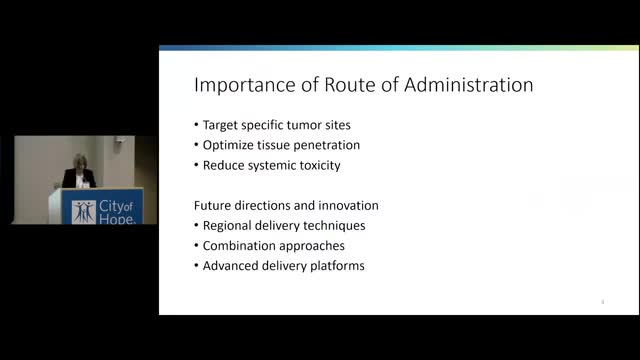Innovative CAR T cell delivery transforms cancer treatment outcomes
June 07, 2024 | California Institute for Regenerative Medicine, Boards and Commissions, Executive, California

This article was created by AI summarizing key points discussed. AI makes mistakes, so for full details and context, please refer to the video of the full meeting. Please report any errors so we can fix them. Report an error »

In a recent discussion on CAR T cell therapy, experts emphasized the critical role of the route of administration in determining treatment efficacy, safety, and patient outcomes. The meeting highlighted how different administration methods can enhance the targeting of tumor sites, which is essential for maximizing therapeutic effects while minimizing adverse effects on healthy tissues.
Intravenous (IV) administration, the most commonly recognized method, allows for widespread distribution of CAR T cells throughout the body, making it suitable for systemic and metastatic diseases. However, this approach carries risks of systemic toxicities, including cytokine release syndrome and neurotoxicity, due to the nonspecific targeting of healthy tissues.
In contrast, intertumoral administration delivers CAR T cells directly to tumor lesions, overcoming barriers that often hinder T cell infiltration in solid tumors. This localized approach not only improves tumor cell killing but also enhances therapeutic outcomes by allowing direct access to the tumor microenvironment. The experts noted that while intertumoral administration can be more effective, it is limited by the accessibility of tumor lesions and may not be feasible for widespread disease.
Subcutaneous administration was also discussed as a less invasive alternative, potentially reducing systemic toxicities. However, its efficacy compared to other methods remains a concern.
The meeting underscored the importance of ongoing research into novel routes of administration and delivery strategies to further improve CAR T cell therapy. Combining CAR T cells with other treatments, such as radiation therapy or immune checkpoint inhibitors, was suggested as a way to enhance the antitumor immune response and improve overall treatment outcomes.
Experts concluded that regional administration of CAR T cells not only minimizes systemic exposure and associated toxicities but also allows for repeat dosing, which could be particularly beneficial for patients with recurrent or refractory solid tumors. The discussion highlighted the need for innovative approaches to optimize CAR T cell delivery, ensuring that patients receive the most effective and safe treatment possible.
Intravenous (IV) administration, the most commonly recognized method, allows for widespread distribution of CAR T cells throughout the body, making it suitable for systemic and metastatic diseases. However, this approach carries risks of systemic toxicities, including cytokine release syndrome and neurotoxicity, due to the nonspecific targeting of healthy tissues.
In contrast, intertumoral administration delivers CAR T cells directly to tumor lesions, overcoming barriers that often hinder T cell infiltration in solid tumors. This localized approach not only improves tumor cell killing but also enhances therapeutic outcomes by allowing direct access to the tumor microenvironment. The experts noted that while intertumoral administration can be more effective, it is limited by the accessibility of tumor lesions and may not be feasible for widespread disease.
Subcutaneous administration was also discussed as a less invasive alternative, potentially reducing systemic toxicities. However, its efficacy compared to other methods remains a concern.
The meeting underscored the importance of ongoing research into novel routes of administration and delivery strategies to further improve CAR T cell therapy. Combining CAR T cells with other treatments, such as radiation therapy or immune checkpoint inhibitors, was suggested as a way to enhance the antitumor immune response and improve overall treatment outcomes.
Experts concluded that regional administration of CAR T cells not only minimizes systemic exposure and associated toxicities but also allows for repeat dosing, which could be particularly beneficial for patients with recurrent or refractory solid tumors. The discussion highlighted the need for innovative approaches to optimize CAR T cell delivery, ensuring that patients receive the most effective and safe treatment possible.
View full meeting
This article is based on a recent meeting—watch the full video and explore the complete transcript for deeper insights into the discussion.
View full meeting
